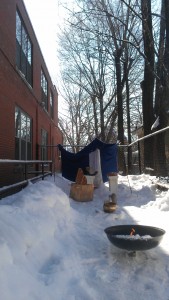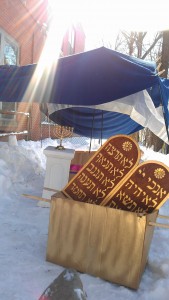Welcome to President’s Day Weekend. How many of you built a Lincoln Log house for your dining room tables this week? We honor our presidents—Lincoln, the son of Illinois, Washington, others.
This celebration fits nicely with this week’s Torah portion. The parsha is a study in leadership. We have several examples—some good, some bad. So before we begin, what is a leader? What is a good leader?
People had good answers to those questions—a leader is a guide, a teacher, someone with vision, sometimes someone who is charismatic although you can be a charismatic leader who is a good leader but is immoral like Hitler, someone who carries out the will of the people or who has the courage to stand up to the people and say no.
As I explained, that seems to be exactly the point of this week’s parsha. We have Moses, G-d. Aaron and Bezalel.
Bezalel is the architect of the mishkan. He takes the design instructions that G-d gave to Moses and the gifts that the people offered, used his skill and his wisdom and built the mishkan. That’s where our parsha begins. Bezazel creating holy space, taking the vision and carrying it out, in all of its nitpicky details. He is a good leader and deserves to have his name remembered.
But then the story goes awry. Moses is still up on the mountain. The mountain was quaking and shaking, smoking and appeared on fire. The people were scared. He hasn’t been heard from in 40 days. Remember, no cell phone to call Tzipporah and say, “Honey, I’m fine, but G-d hasn’t finished talking with me. I’ll be a little late, dear. Don’t worry.” Moses must have died. He was their leader, their caretaker, their conduit to the Divine. He took them out of Egypt, made the Red Sea part, gave them manna and water in the wilderness. Without him, how could they survive? What kind of G-d would do this? What kind of leader would bring them out into the wilderness to die? They wanted to go back to Egypt, where they were safe—even if they were slaves. They wanted to build a golden calf, like the idols they knew in Egypt.
“When the people saw that Moses was so long in coming down from the mountain, they gathered round Aaron and said, ‘Come, make us a god who will go before us. As for this man Moses who brought us up out of Egypt, we don’t know what has happened to him.’ Aaron answered them, ‘Take off the gold earrings that your wives, your sons and your daughters are wearing, and bring them to me.’ So all the people took off their earrings and brought them to Aaron. He took what they handed him and he fashioned it with a tool and made it into a molten calf. Then they said, ‘This is your god, Israel, who brought you up out of Egypt.’ (Ex. 32: 1-4)
So what kind of leader is Aaron? At this juncture he finds a way to do what the people want. But then, like Adam and Eve, he makes excuses. He denies responsibility. He blames the people. He didn’t really make the calf. He just threw the gold into the fire and out came the idol, fully formed.
Rabbi Lord Sacks in his weekly message teaches that “Leaders can fail for two kinds of reason. The first is external. The time may not be right. The conditions may be unfavourable. There may be no one on the other side to talk to…Sometimes despite your best efforts, you fail. Such is life. The second kind of failure is internal. A leader can simply lack the courage to lead. Sometimes leaders have to oppose the crowd. They have to say No when everyone else is crying Yes. That can be terrifying. Crowds have a will and momentum of their own. To say No may be to put your career, even your life, at risk. That is when courage is needed, and not showing it can constitute a moral failure of the worst kind.”
What about G-d as leader. He becomes angry. Very, very angry. He wants to deny that the Israelites are His people. Watch the pronouns as Moses pleads with G-d to spare them. Suddenly they are Moses’s people or just the people. He wants to destroy them all.
What about Moses as leader? He pleads for his people. He is audacious enough to remind G-d that they are G-d’s people. His argument is successful and the Israelites are spared. This is Moses’s finest hour some have said. It becomes the basis of how to plead with G-d for forgiveness and sets up much of the liturgy for Selichot and Yom Kippur. A good strong leader.
A midrash from Berachot 32a teaches us about leadership. “And the Lord spoke to Moses, ‘Go down at once!'” (Exodus 32:7): What is the meaning of “Go down at once”? Said R. Eleazar, “Said the Holy One, blessed be he, to Moses, ‘Moses, go down from your position of greatness. Have I made you great for any reason other than for Israel? Now “Immediately Moses grew weak and did not have the power to speak.” When he said to him, ‘Leave me alone that I may destroy them’ (Deuteronomy 9:14), Moses thought, ‘This matter now depends on me.’ “Immediately he stood and become strong in prayer and sought mercy.” The matter may be compared to the case of a king who grew angry with his son and was giving him hard blows. The king’s friend was sitting before him, afraid to say anything to him. The king said, ‘Were my friend not here, sitting before me, I should have killed him.’ “The other realized, ‘This matter depends on me.’ Immediately he stood up and saved [the son].”
Rabbi Michael Pitkowsky says that this is “how a leader should react when he or she is faced with a crisis. According to this midrash, leaders should not remain aloof and above the people, rather, they must “go down” from their greatness. While it may be easier for a leader who is facing a crisis to try and stay above the fray, Moses’s success was based upon his ability to lower himself in order to help lift up others. “
A good leader then is one who humbles himself, (or herself!) is able to be on the people’s level and see what they want. It is like we learn in the Talmud, “Puk Hazei Mai Amma Davar – go see what the people are doing” (Berachot 45a, Eiruvin 14b).
But more to the point it is what the community needs. What happens when what a community needs is in conflict with what they want? When Moses returns down the mountain, he is angered. Like G-d he is angered. Very, very angry. He smashes the 10 Commandments. He grinds the calf to dust and makes the Israelites drink it. He kills 3000. This leadership makes us uncomfortable. It should.
How does this relate to us? Each of us has the potential to be a leader. To be a Bezalel, building something out of the free will gifts the people offer. To be an Aaron and listen to the will of the people. To be a Moses, and bring a vision to the people. Each of us has the opportunity to be angry or to be a peacemaker.
I have said often that we are on the cusp of a paradigm shift in Judaism. Our models of how we organize Judaism are changing. We can be angry leaders saying things like the young people don’t understand, they are not really being Jewish, they don’t care, they don’t give, they don’t volunteer. OR we can figure out how they want to engage, what they want to do, how they want to give and build our community, our structures and infrastructures. Recently I read an article written by Daniel Gordis about the problems in the Conservative Movement. His contention is that the problem in the Conservative Movement began when the rabbis were able to justify driving on Shabbat. The article is worth the read (and it is long). http://jewishreviewofbooks.com/articles/673/cognitive-dissonance/?utm_source=%22Cognitive+Dissonance%22+and+Its+Uses+%28Jewish+Review+of+Books%29&utm_campaign=Cognitive+Dissonance+%28JRB%29&utm_medium=email
His initial point, “Conservative Judaism was never sufficiently aspirational. Instead of insisting that halakha might give congregants aspirational ideals, it recalibrated Jewish practice for maximum comfort. It failed to recognize that the space between the “is” and the “ought” is where we grow deeper,”is right on target. What the Israelites wanted when they demanded a golden calf was reassurance, comfort and a connection with the Divine who seemed hidden and distant. That’s what we all want. That was the point of the whole sacrificial system, according to Rabbi Nehemia Polen, when I was honored to study Leviticus with him. When the Temple was built, it was to reassure the people, to combine the elements at Mount Sinai, smoke and fire, mountain, the Presence of the Divine. When the Temple was destroyed, the rabbis had to revamp. Judaism became a religion of halacha and study.
However, in the end, I think he misses the point. A return to a strict halacha is not the answer. The people don’t want it and wont’ do it. As Rabbi David Mark says in his comments to the long article, “Every Jew writes her own Shulchan Aruch, her own “Code of Jewish Law.” It doesn’t have to make sense. Faith, Religion, folkways– they aren’t supposed to make sense. When Jews come together in a congregation, they decide on which customs and laws make them feel holier as a group.”
Our job, then as Jewish leaders is to educate, educate, educate, (on this point I agree with Rabbi Gordis) so that people can write their own Torah, write their own Shulchan Arukh. So that we can feel connected with the community, the Jewish community. So that we can feel connected to the long chain of Jewish tradition. But most importantly so we can reconnect with the Divine.
Rabbi Lord Sacks said, “It is easy to be critical of people who fail the leadership test when it involves opposing the crowd, defying the consensus, blocking the path the majority are intent on taking. The truth is that it is hard to oppose the mob. They can ignore you, remove you, even assassinate you. When a crowd gets out of control there is no elegant solution.”
Ultimately, tradition dealt kindly with Aaron. He received the honor of becoming the High Priest. He is portrayed as a man of peace. As we learned, there is more than one kind of leadership. Priesthood requires following the rules and not being swayed by the people. Moses and Aaron were not leaders in the same mold. Our synagogue president and I are not leaders in the same mold. And that’s OK. Neither Moses or Aaron are failures. Neither Joe or I are failures either. We have different roles. The synagogue president has to deal with the finances and maintaining the building. I have to deal with people’s ethics and their pysches and their spirits. I have to find ways to be aspirational to everyone who walks through the doors of this building. Everyone. Both Joe and I have an obligation to uphold the vision of the community, which is based in Jewish tradition. Both Joe and I have an obligation to try to lead from a position of compassion and to be slow to anger. However, when we get angry, and it happens occasionally, we need ways of working it out. That is why our weekly meeting, face to face, like Moses and G-d did, is so critical to our leadership.
Rabbi Zuziya had it right. When he gets to heaven, he will not be asked, “Why were you not Moses?” The question will be “Why weren’t you Zuziya.” None of us are called upon to be Bezalel, Moses or Aaron. We are called on to be ourselves, our best selves. Sometimes we need leaders who can stand up to the crowd. Sometimes we need peacemakers. Sometimes we need builders. Sometimes we need quiet dreamers. No one person can do everything.
So it is a question of both/and. We need leaders who will humble themselves and go down among the people. They are the ones that will have the courage to stand up and say, “That is not right, we cannot do that.” And we need leaders who will build consensus and follow the will of the people. They can become the peacemakers. In this room we have many different kinds of leaders. Each of you in this room (or reading this on the blog) are a leader. The challenge of this week’s parsha is to figure out what kind of leader are you?


